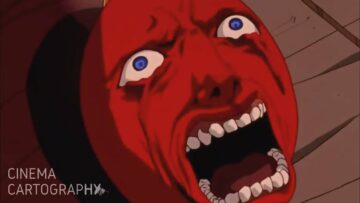

Movies have heroes and villains. Or at least children’s movies do; the more sophisticated the audience, the hazier the line between good and evil becomes, until it finally seems to vanish altogether. Not that cinema directed toward genuinely mature audiences dispenses with those concepts entirely: rather, it makes art out of the ambiguity and interpenetration between them. This is true, to an extent, even in some of the recent wave of big-budget superhero movies, in the main exercises in rolling an “adult” texture onto stories essentially geared toward adolescents. Hence the appearance of the Joker, Batman’s grinning arch-nemesis, in “The Aesthetic of Evil,” the Cinema Cartography video essay above.
In the Joker of Christopher Nolan’s The Dark Knight, “we see an evil that’s relentless, primarily because the core function is complete and total anarchy. Whatever order is established, whoever it’s under ,must be destroyed. As a result, an epoch is created where any rules or codes of conduct are broken. Anything that you anticipate will happen, will result in the opposite.”
This Joker made an outsized cultural impact with not just the explicitness of his disorder-oriented morality, but also a material-transcending performance by Heath Ledger. In that same era, Jamie Hector took a comparatively minimalist but equally memorable turn in David Simon’s series The Wire as Marlo Stanfield, a drug kingpin “too villainous for the villains.” Like the Joker, Marlo is a law unto himself, “willing to destroy the equilibrium of any facet of the world there is, on a whim.”
These two represent just one of the forms evil has taken in recent decades. The essay’s other examples range from Psycho‘s Norman Bates and 2001’s HAL 9000 to The King of Comedy‘s Rupert Pupkin and Fanny and Alexander‘s stepfather Edvard — or rather, the unwelcome transformation of the family Edvard represents. The most diabolical evil does not confine itself within the person of the antagonist, especially not in the work of Michael Haneke, which twice appears in “The Aesthetic of Evil.” Benny’s Video is on one level about a murderous adolescent; on another, it’s about the “evasion of the real” that seduces us all. The White Ribbon is on one level about random acts of violence in a small village; on another, it’s about how evil reflects “the collective consciousness of a society.” Haneke’s films have often been described as difficult to watch, and that may well have less to do with what they show than what they know: even if we aren’t all villains, we’re certainly not heroes.
Related Content:
Orson Welles on the Art of Acting: ‘There is a Villain in Each of Us’
Rare Video: Georges Bataille Talks About Literature & Evil in His Only TV Interview (1958)
The Aesthetic of Anime: A New Video Essay Explores a Rich Tradition of Japanese Animation
The Dark Knight: Anatomy of a Flawed Action Scene
Based in Seoul, Colin Marshall writes and broadcasts on cities, language, and culture. His projects include the Substack newsletter Books on Cities, the book The Stateless City: a Walk through 21st-Century Los Angeles and the video series The City in Cinema. Follow him on Twitter at @colinmarshall or on Facebook.
The Aesthetic of Evil: A Video Essay Explores Evil in the Films of Bergman, Hitchcock, Kubrick, Scorsese & Beyond is a post from: Open Culture. Follow us on Facebook and Twitter, or get our Daily Email. And don't miss our big collections of Free Online Courses, Free Online Movies, Free eBooks, Free Audio Books, Free Foreign Language Lessons, and MOOCs.

0 Commentaires